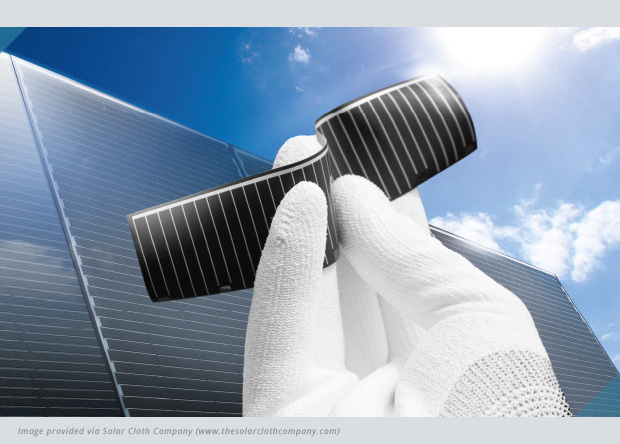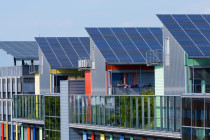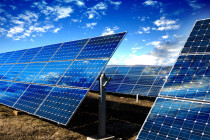The old saying goes, “a stitch in time saves nine.” But what if a stitch could save energy? It’s something that assistant professors Marianne Fairbanks and Trisha Andrew at the University of Wisconsin-Madison are considering as they work together to create innovative solar textiles.
Their collaborative partnership is a fascinating example of design and technology coming together to spark creative solutions. Fairbanks is an assistant professor in the School of Human Ecology’s design studies program while Andrew is an assistant professor of chemistry working within the fields of chemistry, materials science and electrical engineering. Fairbanks brings to the table several years of experience working with dyes, fibres and design, and is a co-founder of Noon Solar, a Chicago-based company responsible for solar-charging handbags. Andrew is celebrated for her work in energy research at UW-Madison, particularly her efforts to create low-cost, lightweight solar cells. In fact, she recently developed an organic dye-based solar cell that can be deposited onto paper. Together they bring a wealth of knowledge and expertise within their specific domains, as well as a passion for making solar energy a viable and affordable option in a multitude of platforms.
While solar textiles have existed on some level for a number of years, the duo’s innovative process helps integrate technologies to help reduce manufacturing costs and processes. Fairbanks and Andrew recently received a grant funded by the Wisconsin Alumni Research Foundation (WARF) and are using the funds to develop new ways to create solar textiles. Says Andrew, “The idea of building solar cells on fabric is potentially transformative. If we take this technology to grow devices on material then we could talk wearable technology, as well as solar curtains, solar umbrellas, solar tents, or applications for the military.”
In one project, materials science and engineering graduate student Lushuai Zhang is using vapour phase chemistry to coat different fabric weave structures with a polymer. Using this coating process, the fabric increases conductivity until it can act as the bottom electrode onto which two different dyes and a top electrode can be connected, resulting in a functioning solar cell.
In another project, Fairbanks suggested weaving techniques may hold the answer to creating solar cells. Because the four layers of a dye-based solar cell do not need to be placed in a particular sequence, Fairbanks proposed they try to create a spool of thread for each of the components (two electrodes and two dyes), which could be weaved together to create a solar cell. Andrew is excited by the potential this collaboration brings to solar technology: “I never would’ve thought of that. If we could literally weave together a solar cell: mind blowing. We’re really integrating each step of the process, on the textile side, on the device side.”
Future plans include the development of a prototype using the coating technique, as well as a proof of concept for the weaving idea. For Fairbanks and Andrew, forging a collaborative relationship rooted in a shared passion for bringing solar technology to the masses has been the best discovery so far, with a promising future ahead. Fairbanks explains: “Science and art aren’t too different. We’re all experimenting. To get to do it together is a dream come true.”
Another interesting solar textile project comes from the Cambridge, England-based Solar Cloth Company. The company specializes in thin film photovoltaic (TFPV) flexible solar panels, which can be used atop low-load bearing structures such as stadiums with retractable roofs, agricultural land covers, supermarket and warehouse roofing, and car parks.
Solar Cloth Company estimates there are approximately 830 square kilometres of roof space and 350 square kilometres of parking space in the U.K. that, if covered with solar cloth, could produce enough solar energy to power the U.K.’s grid three times. The company won the Solar U.K. Industry Awards’ Building-Integrated Photovoltaic (BIPV) Solar Innovation of the Year in 2014 and has had sales of over £380,000 for this year with strong interest and major projects already in the pipeline for the immediate future.
According to Hans Haenlein, member of the Advisory Board for The Solar Cloth Company, “One of the main hindrances to solar panel adoption is that they can be difficult to install and integrate with existing architecture functionally and aesthetically. Flexible solar cloth overcomes all of these problems and can add real value to existing and upcoming sites.”
Whether it’s unique collaborations that bring different disciplines together, or exploring new and exciting applications, solar energy innovation continues to thrive with far-reaching potential.
About The Author

-
Serial Entrepreneur, Technologist and Inventor.
My objective is to develop useful products that have a net positive effect in the lives of those that use them and the environment that we live in.
CEO of Mission LED Lighting Company Ltd.
- 2017.05.24LED factsWhy Are Cars Switching to LEDs if They’re Too Bright?
- 2017.05.09Be green & saveHow to Easily Replace T8 Fluorescent Tubes With LED
- 2017.03.07Build a better future7 Things About Explosion Proof LED Lighting You Should Know
- 2017.02.28Be green & saveWhy We Love LED Grow Lights (And You Should, Too!)





Leave a Reply